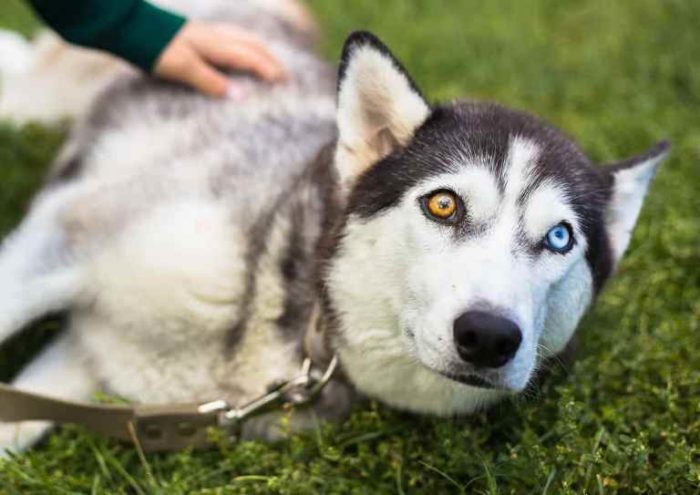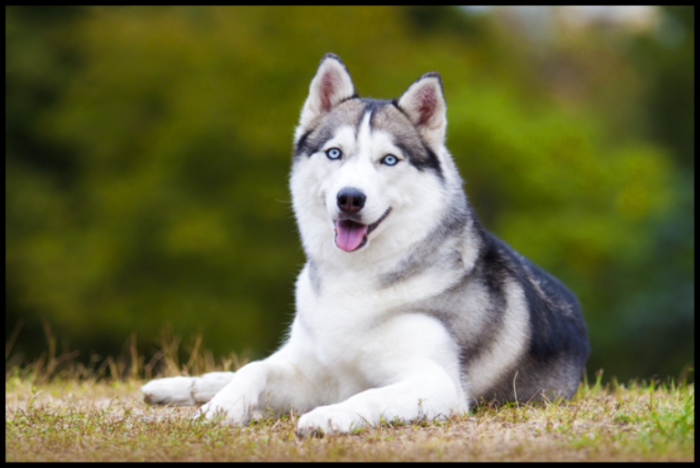The Siberian Husky is a highly energetic dog that needs loads of daily exercise and mental stimulation to be happy. This beautiful breed is one of the canines that have a very close resemblance to wolves. Just looking at what is referred to as its “face mask” is enough to make anyone believe that the dog is a direct descendant of wolves. Huskies have this piercing bright almond-shaped eyes that can hold you spellbound; this has led many prospective parents to end up choosing the breed as a family dog.
Table of Contents
History Of The Siberian Husky
It is generally believed that the Siberian Husky originated from a tribe of Siberian nomads called the Chukchi. The history of the breed is relatively unknown, however, confirmations from DNA tests say they belong to the oldest of canine breeds. The Chukchi, according to history, used the breed as a form of fast transportation and it lived as a family dog, interacting with the nomads. Oftentimes, it slept with the kids, providing them with warm and comfortable beds.
In 1908, the breed was imported into Alaska where it functioned as sled pups during the gold rush. The natives used them in the All-Alaska Sweepstakes – a 408-mile dogsled race, and even today, it has continued to be a highly active competitor during contests. According to kept records, it was in 1930 that the last Siberian Husky was moved/exported out of Siberia as the Soviet government closed the borders. The breed presently thrives in North America and though they went through slight changes from their origin as Siberian foundation pups – the Chukchi Sled Dog, many great qualities of the breed are still maintained.
The American Kennel Club recognized the Siberian Husky in 1930, in 1939, it received recognition from the Canadian Kennel Club, and in 1938, they founded the Siberian Club of America.
Physical Appearance Of The Husky
The Siberian Husky is a beautiful breed with some really exceptional physical traits, including a beautiful smile; below are some of its distinguishing features;
Face
Also called masks, the face of the husky often comes in white and is distinguished by a lengthened snout (this helps warm the air when in cold climates) plus an alert and focused expression. At first glance, a Siberian Husky appears almost too striking for one to approach until its jaw comes dropping down and out rolls the tongue and a bright natural smile!
Eyes

The apt word to describe the beauty of the Siberian Husky is “striking” The dog can hold your gaze with piercing bright almond-shaped eyes occurring in colors like blue, brown, amber, bi-eyes (one blue and one brown) or parti-eyed, (half-blue and half-brown)
Nose and Ears
The nose of the Siberian Husky is neither pointed nor square and may come in liver, black, or flesh-colored, depending on the dog’s coat color. Sitting up high on the husky’s head are a pair of triangular ears.
Tail
The tail of the Siberian Husky is comparable to that of a fox, thanks to its thick fur that gives it a similar shape. Usually, it curves upwards whenever the pup is at attention, but when it is resting, you will see a trailing tail.
Coat Length
A double-coated pup with medium-length hair, the Siberian Husky sports a soft, thick undercoat alongside thick outer longer guard hairs. The two-layered insulated coat of the husky provides it with protection against cold. The coat comes in different shades of colors – gray, sable, red, agouti, black, and snow-white, patterned in different variations of black-and-white, red-and-white, and gray-and-white.
Its muscular shoulders are encircled by vibrant hues rising to the tips of the dog’s high triangular-shaped ears. The color goes on to form what is best referred to as a forehead cap, creating an illusion of two raised eyebrows. This becomes evident when the beautiful pup looks at the owner to determine the next line of action.
Body Build
Built for both speed and endurance, the Siberian Husky breed is quite compact, standing about 21 to 23 inches high at the withers with a body mass of 45-60 pounds for the male. The female comes way lower with a weight of 35-50 pounds and standing 20-22 inches. The dog’s body is evenly proportioned and can be best described as sleek – from the tip of its nose to the end of that long bushy tail, the husky is a sight to behold. Its hindquarter which is slightly angled helps in propelling him forward.
Feeding
Meals for the Siberian Husky can be divided into two portions consisting of 1.5 to 2 cups of high-quality dry kibble daily. The Husky is an “easy keeper” with respect to mealtimes; the reason is that they don’t need to consume a large quantity of food. This trait is traceable to their origin; Chukchis used them in pulling light loads at a very fast pace over long distances in cold temperatures on minimum intake of food.
However, the quantity of food your husky eats is dependent on a lot of factors – age, size, metabolism, build, activity level, and the likes – a highly active dog will likely eat more than a docile dog. The quality of kibble you buy also makes a world of difference – high-quality dog food will nourish your dog’s body and you may end up shaking less into it its food bowl.
Health and Lifespan
Relative to other breeds of canine, the Siberian Husky has a long life expectancy that spans from 12 to 15 years and it stays fairly healthy throughout its lifetime. The dog is kept lean due to its eating habit, metabolism, and high exercise needs, thus, does not suffer too many ailments. However, pet parents who keep the breed should watch out for eye problems and hip dysplasia.
Hip Dysplasia
This can either develop over time or maybe as a result of a genetic condition. It is a form of painful arthritis that occurs when the cartilage begins to wear away in-between the bones or the pup’s thigh bone fails to fit snugly in the hip socket. Mild cases of hip dysplasia can be eased by medication prescribed by the vet but surgery must be done for severe cases.
Eye Problems
The Siberian Husky suffers three kinds of eye problems that may lead to blindness: corneal dystrophy, progressive retinal atrophy, and juvenile cataracts. Even without sight, the breed can still live a fulfilled and rich, full life.
Read Also: 12 Dogs With Curly Tails
Temperament
The Siberian Husky’s has a friendly disposition, a highly energetic dog, fun-loving, smart, curious alert, independent, active, and more. However, they can be quite mischievous which calls for an active owner with enough time for daily exercise. If allowed, your husky is ready and willing to chase and romp all day long. Naturally a pack animal, this pooch needs constant interactions with humans, and other dogs, thus, arranging several dog park playdates with dogs of similar size is not a bad idea.
The dog does not bark much but it is highly talkative – moaning and whining mean that your furbaby wants to get your attention. You may hear some long, melodic howls in response to other Siberians, a passing siren, or as a way of saying good morning.
Huskies are prone to separation anxiety. So, leaving the pup alone for long may lead it to break free from its leash, crate, fence, or whichever restriction is placed on it. The breed doesn’t live to please anybody but will adore being part of a family. The dog’s high prey drive makes it unsuitable for multi-pet households with cats and smaller dogs and it may not be wise to adopt a husky in a family with toddlers.
Grooming
The Siberian Husky is described as self-cleaning, thus, may just need a few baths in a year. During the “blowing coat” process, your husky will require regular brushing on a daily basis to get rid of dead hair and the old undercoat. However, you may not need to brush much during normal times. To prevent periodontal disease, the teeth of your dog should be brushed daily. However, if you can’t meet up with the daily brushing, once or twice weekly will suffice. Be sure to use safe toothpaste for dogs. The nails should be clipped bi-weekly or when due, the ears equally need cleaning when they are dirty.
Do Siberian Huskies Make Good Family Pets?
Yes. The breed was developed with a good temperament which makes it ideal for family settings. Notwithstanding, if there are toddlers in the family, more attention should be placed on the dog to avoid any mishap. Overall, Huskies have been enjoyed by families since the breed came into existence. It serves as a good companion, especially during cold weather when its owners sleep beside them to enjoy the warmth that emanates from its coat.
First-time pet parents will enjoy having a Siberian Husky as a companion due to its favorable temperament and loyalty to family, among so many other traits that make the breed stand out. The Husky doesn’t just look like an angel, it acts like one.
